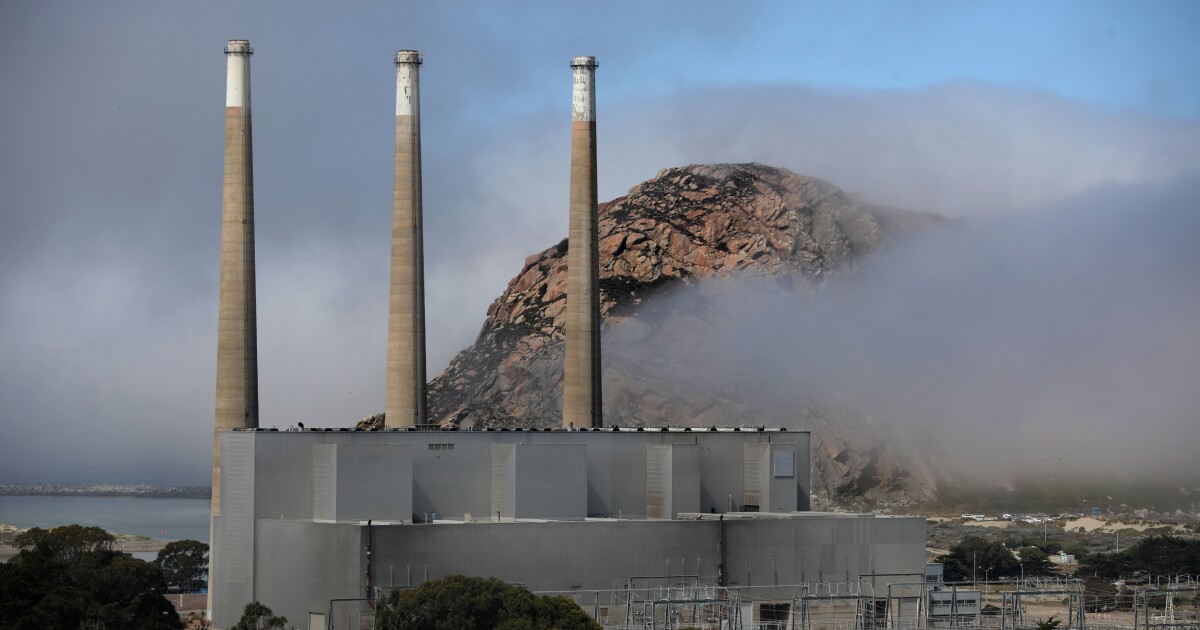
In a coastal California town, three iconic smokestacks are coming down. A community mourns
In this foggy Central Coast fishing town, two icons tower above everything.
One is Morro Rock, the 23-million-year-old plug of an ancient volcano, rising 576 feet out of the sea. The other is a trident of 450-foot concrete smokestacks, built half a century ago for a seaside power plant.
Together, they give Morro Bay its nickname: Three Stacks and a Rock.
Outsiders may see the humble smokestacks as industrial blight. But here, they became a cherished symbol of the town’s working-class ethos.
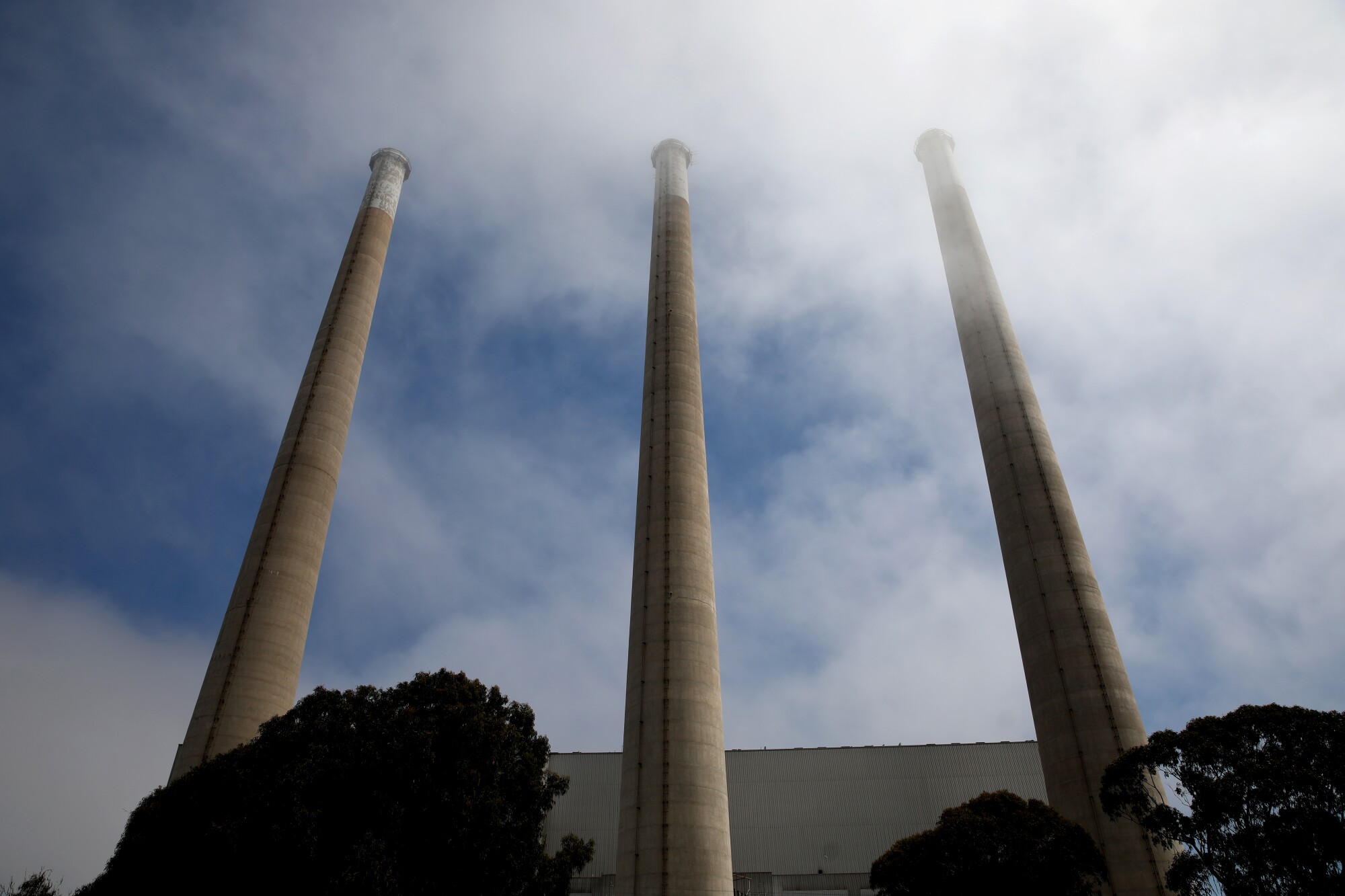
The smokestacks in Morro Bay gave the town its nickname, ‘Three Stacks and a Rock.’
(Gary Coronado / Los Angeles Times)
Fishermen used them as a lighthouse beacon to guide them home from sea. Local surfers paddled out knowing where the plant’s outflow would warm up the waves. Shop owners sold T-shirts, coffee mugs and paintings bearing their image.
A brewery was named Three Stacks and A Rock. A bistro was dubbed STAX.
But times change. The planet warmed. The power plant became a relic in an era when California is moving toward renewable energy. It shut down eight years ago, and it’s not coming back.
Soon, the smokestacks will come down. Many in the town are heartbroken.
“Everyone comes to Morro Bay to see Three Stacks and a Rock,” said Bud Hurless, 30, as he unloaded a fishing boat on a recent morning.
“And now it’s going to be, ‘Come to Morro Bay for — a rock!’ It sounds pretty bad. I’d be super bummed.”
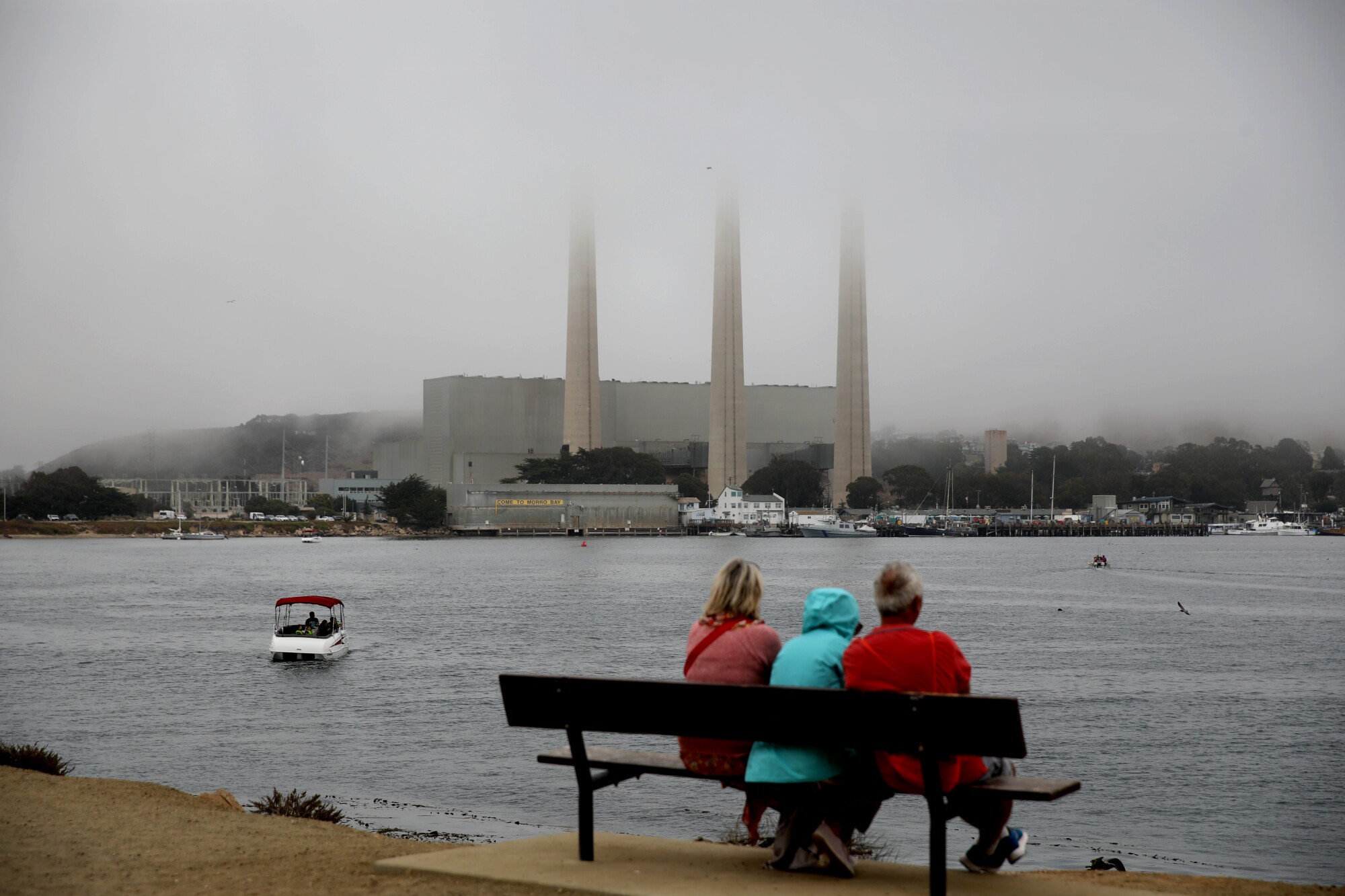
For many Morro Bay visitors, the smokestacks are an eyesore. But to locals, they’ve come to symbolize the community’s working-class ethos.
(Gary Coronado / Los Angeles Times)
In many ways, the Morro Bay power plant site represents the evolution of energy in the Golden State.
Built by Pacific Gas and Electric in the 1950s, the plant was first run on oil, and the stacks belched black smoke, leaving soot on cars and homes. It eventually transitioned to natural gas before shutting down in 2014.
Now, Vistra Corp., a Texas energy company that owns the site, is proposing building what would be one of the world’s largest lithium-ion battery storage facilities there. And there are ongoing discussions about connecting a planned offshore wind farm to the power grid using existing infrastructure on the property.
“This ‘stacks to storage’ concept transitions a retired fossil fuel site into a renewable energy center repurposing the existing infrastructure, saving time and money,” Vistra Corp. spokesman Brad Watson said in an email.
But the drama over what to do with the smokestacks stands as a harbinger of conflicts to come in California, where state law requires that all of the state’s electricity come from clean energy sources by 2045.
As the state makes that transition, more communities will be forced to deal with the hulking industrial infrastructure that will be left behind.
“Man-made structures have a life cycle,” said Erin Pearse, director of the Initiative for Climate Leadership and Resilience at Cal Poly San Luis Obispo. “There are obviously a lot of advantages to trying to convert these facilities into something else that could be used — maybe in a similar way, maybe in a different way — but at least reused.”
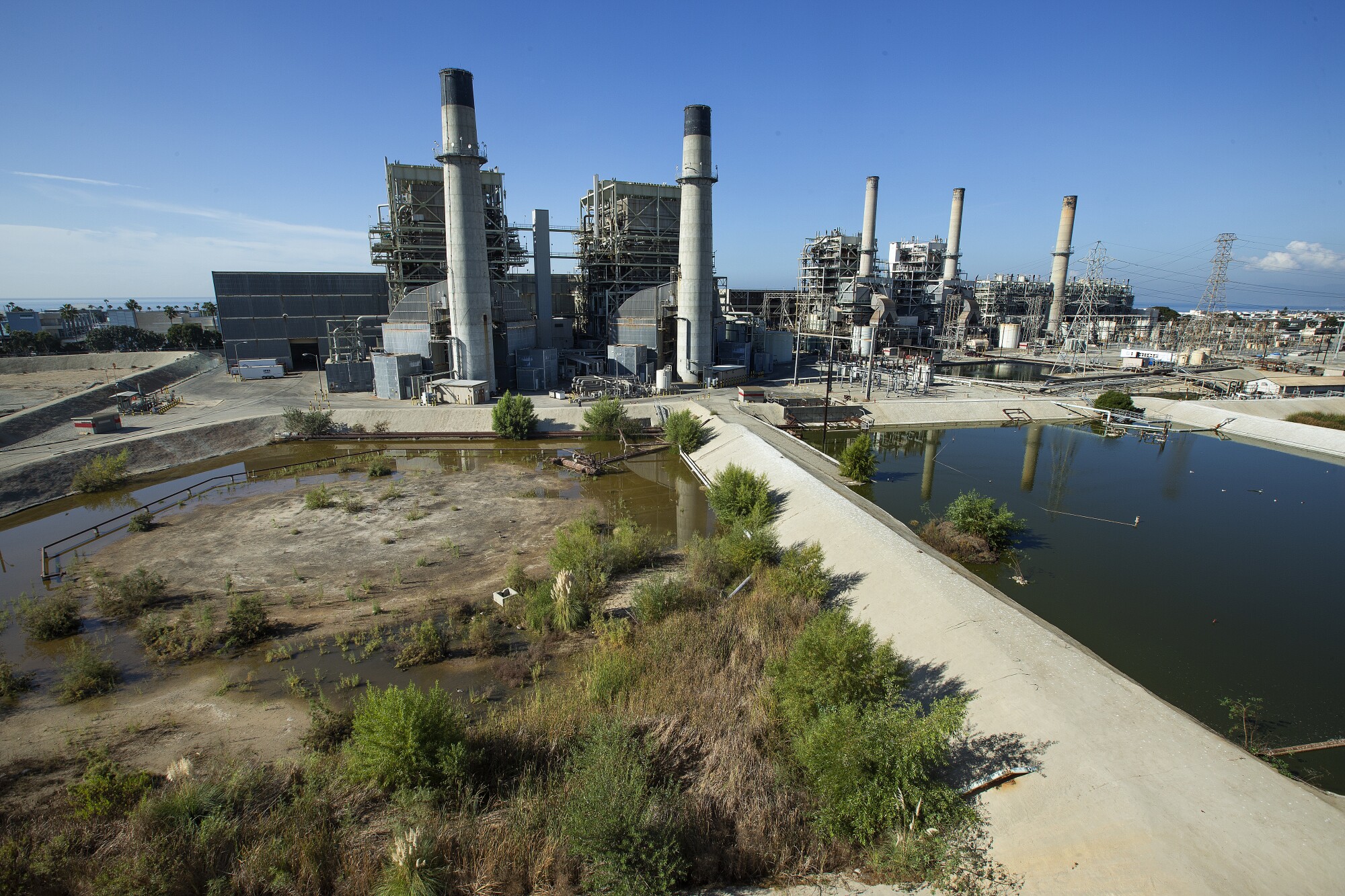
This waterfront AES power plant in Redondo Beach has been slated to close but has had its operational life extended. Residents have long fought to have it torn down and turned into a park.
(Mel Melcon / Los Angeles Times)
Such decisions are complicated because the sites are often decades old and contaminated. And, in the case of underwater structures such as oil platforms off the coast, marine ecosystems have sprung up on and around them, and removal might be even more harmful, Pearse said.
But the energy transition, he said, is urgently needed because of climate change.
“People are finally starting to get it,” he said. “They’re seeing the fires, they’re seeing the heat waves, they’re seeing all the associated weather events, and it’s forming too strong a pattern to be denied.”
What that transition means for huge, polluting structures has looked different up and down the coast.
Last year, a 400-foot smokestack at the shuttered 1950s-era Encina Power Station in Carlsbad was torn down, over the objections of preservationists. The future of the site is undecided.
In Redondo Beach, the gas-fired AES Corp. power plant on the waterfront has been slated for closure for years but recently had its operational life extended at least through the end of 2023 because of punishing heat waves and potential power shortfalls. Residents have long been fighting for the plant to be demolished and the site made into a public park and for its wetlands to be restored.
And in San Francisco, the waterfront site of the Potrero Power Station that closed in 2011 is undergoing a $2-billion redevelopment that will include the building of about 2,600 housing units, a hotel, and park space. The 300-foot smokestack will be incorporated into the design.
In Morro Bay, the smokestacks loom over a small city of low-slung buildings and 10,700 residents.
Here, the air is briny and the fog rolls in so thick that the stacks can disappear several times a day.
The deteriorating plant, which once provided energy to hundreds of thousands of homes along the Central Coast and in the Central Valley, is filled with asbestos, aging control panels, and seabird poop.
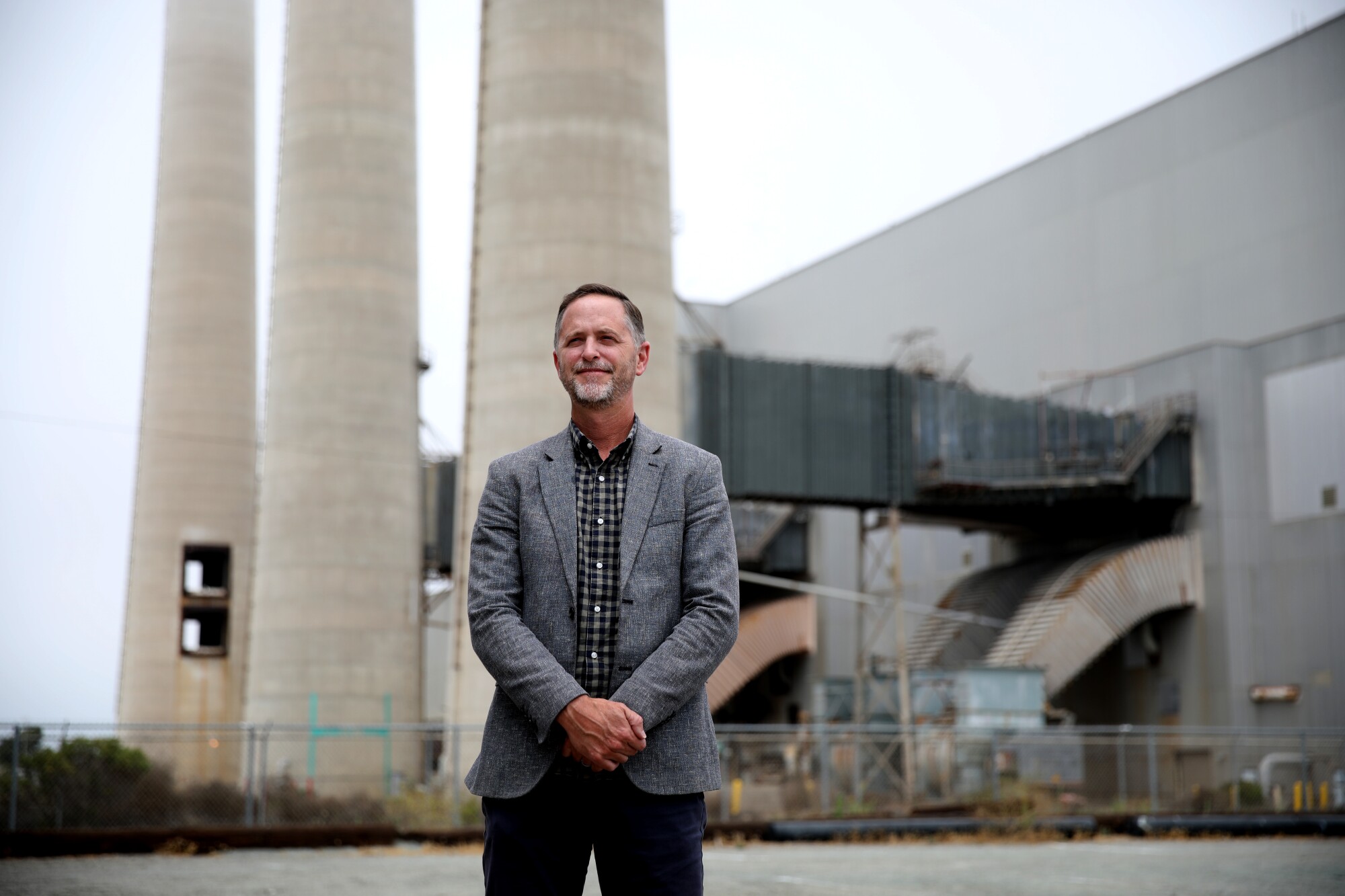
Morro Bay City Manager Scott Collins said it is too expensive for the city to pay to maintain the smokestacks, which have no functional use.
(Gary Coronado / Los Angeles Times)
Morro Bay City Manager Scott Collins said it looks like a cross between the nuclear plant where Homer Simpson worked and something from the set of the TV series “Lost.”
“It’s a time warp when you walk in there,” he said. “There’s feces everywhere.”
Last fall, the Morro Bay City Council voted to have the smokestacks torn down.
They stand on private property owned by Vistra Corp., which gave the city the option to keep the smokestacks up — if it took on liability costs and paid to maintain them.
Annual costs would include inspections of up to $50,000 and maintenance of up to $30,000, and the city would have to pay more than $750,000 to place caps atop each one to protect their interiors. Tearing them down on the city’s dime would be $5 million to $10 million, Collins said.
“For a city that’s small like us, where we struggle to pave our streets and take care of our harbor … we’re not going to take on another asset that has no real economic value,” Collins said. “You can’t turn the stacks into a money generator.”
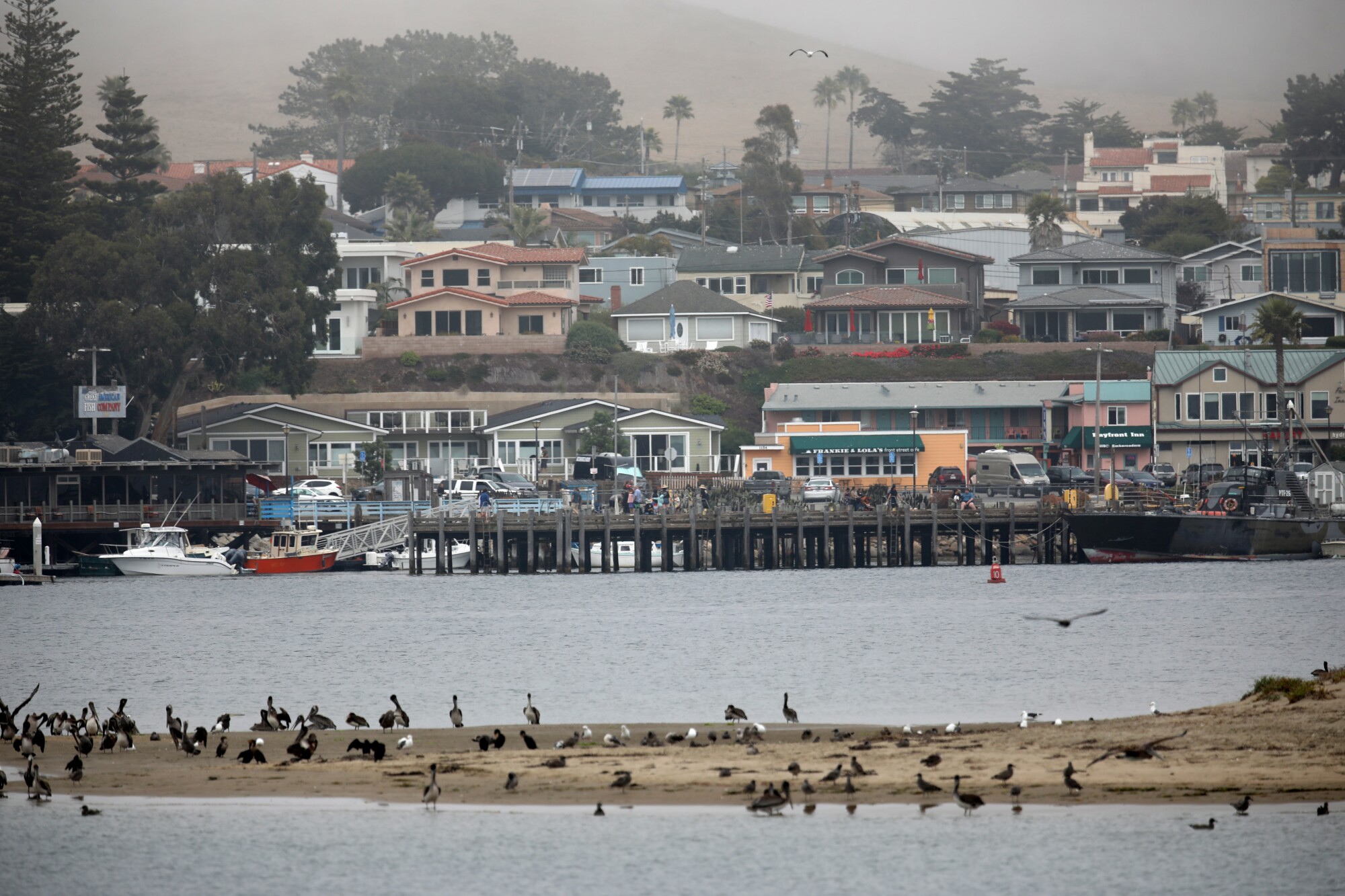
Homes dot the landscape behind the Embarcadero in Morro Bay.
(Gary Coronado / Los Angeles Times)
The city and Vistra came to an agreement: The company will tear down the plant and smokestacks by Dec. 31, 2027, or it will pay Morro Bay $3 million.
The stacks will not be imploded. They will be chipped away, starting at the top, with the concrete pieces dropped down the center of each column.
Vistra has submitted plans to the city to construct a 22-acre lithium-ion battery energy storage system, similar to one it owns and operates in Moss Landing in Monterey County.
The Morro Bay power station would house around 180,000 battery modules that would hold energy produced elsewhere and release it to the power grid via an existing PG&E switchyard adjacent to the site. It could power up to 450,000 homes.
And, Collins said, it could store energy generated by an enormous floating wind farm proposed for 20 miles off the coast of Morro Bay.
With the Diablo Canyon nuclear plant near San Luis Obispo scheduled to close by 2025, “the need for significant energy storage on the Central Coast is critical,” Vistra said in a planning application.
Despite the potential, Collins said, there are genuine concerns among residents about the demolition of the smokestacks changing the character of the blue-collar community.
They worry about overdevelopment and being priced out of their gorgeous slice of California coast. A common refrain is: Don’t let Morro Bay become too much like ritizier beach towns like Cambria or Carmel.

Mike Jones, 49, owns the Azhiaziam surf shop near to the defunct Morro Bay smokestacks that are supposed to be demolished by the end of 2027.
(Gary Coronado/Los Angeles Times)
City officials and Vistra are discussing some kind of monument — maybe a plaque — to honor the smokestacks and the importance of the energy industry in Morro Bay, which incorporated in 1964 after the power plant gave it enough of a tax base to do so.
But a plaque won’t quite assuage the heartache.
Residents are quick to offer ideas for what the smokestacks could become. An art installation. An observation deck, perhaps. Some have even suggested running zip lines from the stacks to Morro Rock.
From his counter at the Azhiaziam (pronounced “As high as I am”) surf shop, owner Mike Jones sees the stacks just beyond his front door, and he sells stickers with their likeness.
“They’re part of the skyline,” Jones said. “The sun sets, and they cast shadows. The sunlight goes through them, and the fog drifts by them. Every day, they’re kind of awe inspiring.”
Jones, 49, grew up in Morro Bay and has spent most of his life here, once basking in water released by the old power plant that was so warm it melted the wax of surfboards.
“You were just surfing in, like, Tahiti water,” he said.
He has used Google Maps to see if his shop would be crushed if the smokestacks crashed down; it wouldn’t, but not by much.
When he posted a photo of the smokestacks on April Fools’ Day saying they were coming down that week, people freaked out, saying they planned to drive from as far as Fresno to see them.
This month, a customer from New York came in and was “bagging on” the smokestacks, calling them ugly.
“Someone from New York talking trash on them? I’m like, you know what? Whatever. You don’t need to bash our town,” Jones said.

Fisherman Bill Blue opposes the demolition of three 450-foot smokestacks in Morro Bay.
(Gary Coronado / Los Angeles Times)
At the docks across the street, fisherman Bill Blue, 66, unloaded scores of black cod from his boat, the Brita Michell, in the shadow of the smokestacks.
Blue came to Morro Bay from Southern California at 18 in 1974, and he’s been fishing in local waters ever since. When he first started — before he had electronic GPS equipment — he used the flashing red lights atop the stacks to orient himself on the sea.
“Once they take those down, the next thing they’ll want to do is take the rock away,” he said, only half joking. Decades ago, people actually did quarry Morro Rock, including with explosives.
Blue envisions an apocalyptic scene of shop and dock closures and people in hazmat suits when the demolition of the asbestos-laden power plant begins.
As one of Blue’s customers, Tanya Hartley of Santa Barbara, packed 300 pounds of black cod into ice-filled coolers in the back of her Dodge Ram, she said the giant concrete cylinders felt like relics. Hartley, 46, who owns an organic farm, said the planet needs renewable energy, not what the smokestacks represent.

Tanya Hartley, 46, of Santa Barbara, shown with dog Suki, loads black cod onto her truck, to be sold at a farmers market.
(Gary Coronado / Los Angeles Times)
Near Morro Rock — where tourists snapped photos of lounging sea otters as the foghorn bellowed its low, mournful call — Diego Avila stopped to gaze at the smokestacks across the water.
Avila, a 46-year-old psychotherapist from London who was visiting a friend, said that while he could appreciate why locals loved them, they seemed “so at odds with the rest of the scenery.”
“They’re so — random.”
Stay connected with us on social media platform for instant update click here to join our Twitter, & Facebook
We are now on Telegram. Click here to join our channel (@TechiUpdate) and stay updated with the latest Technology headlines.
For all the latest Education News Click Here
For the latest news and updates, follow us on Google News.

